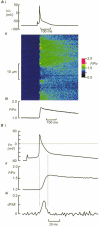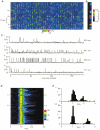Properties of Ca2+ sparks evoked by action potentials in mouse ventricular myocytes
- PMID: 10381593
- PMCID: PMC2269442
- DOI: 10.1111/j.1469-7793.1999.0469p.x
Properties of Ca2+ sparks evoked by action potentials in mouse ventricular myocytes
Abstract
1. Calcium sparks were examined in enzymatically dissociated mouse cardiac ventricular cells using the calcium indicator fluo-3 and confocal microscopy. The properties of the mouse cardiac calcium spark are generally similar to those reported for other species. 2. Examination of the temporal relationship between the action potential and the time course of calcium spark production showed that calcium sparks are more likely to occur during the initial repolarization phase of the action potential. The latency of their occurrence varied by less than 1.4 ms (s.d.) and this low variability may be explained by the interaction of the gating of L-type calcium channels with the changes in driving force for calcium entry during the action potential. 3. When fixed sites within the cell are examined, calcium sparks have relatively constant amplitude but the amplitude of the sparks was variable among sites. The low variability of the amplitude of the calcium sparks suggests that more than one sarcoplasmic reticulum (SR) release channel must be involved in their genesis. Noise analysis (with the assumption of independent gating) suggests that > 18 SR calcium release channels may be involved in the generation of the calcium spark. At a fixed site, the response is close to 'all-or-none' behaviour which suggests that calcium sparks are indeed elementary events underlying cardiac excitation-contraction coupling. 4. A method for selecting spark sites for signal averaging is presented which allows the time course of the spark to be examined with high temporal and spatial resolution. Using this method we show the development of the calcium spark at high signal-to-noise levels.
Figures




References
-
- Barcenas-Ruiz L, Wier WG. Voltage dependence of intracellular Ca2+ transients in guinea pig vetricular myocytes. Circulation Research. 1987;61:148–154. - PubMed
-
- Bers DM. Excitation-Contraction Coupling and Cardiac Contractile Force. Dordrecht: Kluwer; 1991.
-
- Bridge JHB, Li J, Ershler PR, Razusova Z, Cannell MB. Calcium sparks and evoked local calcium transients in mouse ventricular myocytes. Biophysical Journal. 1998;74:A118.
-
- Cannell MB, Berlin JR, Lederer WJ. Effect of membrane potential changes on the calcium transient in single rat cardiac muscle cells. Science. 1987;238:1419–1423. - PubMed
Publication types
MeSH terms
Substances
LinkOut - more resources
Full Text Sources
Research Materials
Miscellaneous

